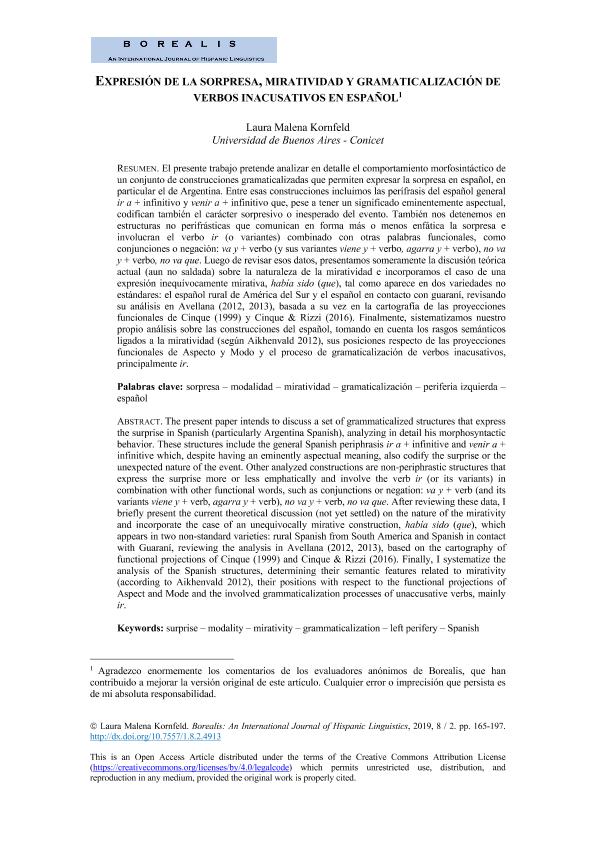Artículo
El presente trabajo pretende analizar en detalle el comportamiento morfosintáctico de un conjunto de construcciones gramaticalizadas que permiten expresar la sorpresa en español, en particular el de Argentina. Entre esas construcciones incluimos las perífrasis del español general ir a + infinitivo y venir a + infinitivo que, pese a tener un significado eminentemente aspectual, codifican también el carácter sorpresivo o inesperado del evento. También nos detenemos en estructuras no perifrásticas que comunican en forma más o menos enfática la sorpresa e involucran el verbo ir (o variantes) combinado con otras palabras funcionales, como conjunciones o negación: va y + verbo (y sus variantes viene y + verbo, agarra y + verbo), no va y + verbo, no va que. Luego de revisar esos datos, presentamos someramente la discusión teórica actual (aun no saldada) sobre la naturaleza de la miratividad e incorporamos el caso de una expresión inequívocamente mirativa, había sido (que), tal como aparece en dos variedades no estándares: el español rural de América del Sur y el español en contacto con guaraní, revisando su análisis en Avellana (2012, 2013), basada a su vez en la cartografía de las proyecciones funcionales de Cinque (1999) y Cinque & Rizzi (2016). Finalmente, sistematizamos nuestro propio análisis sobre las construcciones del español, tomando en cuenta los rasgos semánticos ligados a la miratividad (según Aikhenvald 2012), sus posiciones respecto de las proyecciones funcionales de Aspecto y Modo y el proceso de gramaticalización de verbos inacusativos, principalmente ir. The present paper intends to discuss a set of grammaticalized structures that express the surprise in Spanish (particularly Argentina Spanish), analyzing in detail his morphosyntactic behavior. These structures include the general Spanish periphrasis ir a + infinitive and venir a + infinitive which, despite having an eminently aspectual meaning, also codify the surprise or the unexpected nature of the event. Other analyzed constructions are non-periphrastic structures that express the surprise more or less emphatically and involve the verb ir (or its variants) in combination with other functional words, such as conjunctions or negation: va y + verb (and its variants viene y + verb, agarra y + verb), no va y + verb, no va que. After reviewing these data, I briefly present the current theoretical discussion (not yet settled) on the nature of the mirativity and incorporate the case of an unequivocally mirative construction, había sido (que), which appears in two non-standard varieties: rural Spanish from South America and Spanish in contact with Guaraní, reviewing the analysis in Avellana (2012, 2013), based on the cartography of functional projections of Cinque (1999) and Cinque & Rizzi (2016). Finally, I systematize the analysis of the Spanish structures, determining their semantic features related to mirativity (according to Aikhenvald 2012), their positions with respect to the functional projections of Aspect and Mode and the involved grammaticalization processes of unaccusative verbs, mainly ir.
Expresión de la sorpresa, miratividad y gramaticalización de verbos inacusativos en español
Fecha de publicación:
12/2019
Editorial:
The Arctic University of Norway
Revista:
Borealis
ISSN:
1893-3211
Idioma:
Español
Tipo de recurso:
Artículo publicado
Clasificación temática:
Resumen
Palabras clave:
Sorpresa
,
Modalidad
,
Gramaticalización
,
Miratividad
Archivos asociados
Licencia
Identificadores
Colecciones
Articulos(SEDE CENTRAL)
Articulos de SEDE CENTRAL
Articulos de SEDE CENTRAL
Citación
Kornfeld, Laura Malena; Expresión de la sorpresa, miratividad y gramaticalización de verbos inacusativos en español; The Arctic University of Norway; Borealis; 8; 2; 12-2019; 165-197
Compartir
Altmétricas




